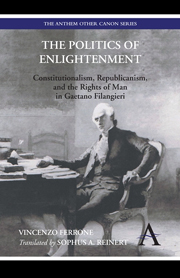 The Politics of Enlightenment
The Politics of Enlightenment from Part One - The New Politics ‘Ex Parte Civium’
Published online by Cambridge University Press: 05 February 2013
As one of the most suggestive and important elements in the construction of a new enlightened constitutionalism, the polemic against British legal, political, and institutional thought inspired by the lessons of the American Revolution was certainly no isolated current in the rhetorical structure of the Scienza della legislazione. The work was in fact consciously constructed though a scheme that, on the one hand, planned a punctilious and caustic critique of Old Regime Europe, of its unfair social and political order, and of its traditional corporative constitutionalism. On the other, it formulated precise proposals for constructing a new society on the basis of legislation re-founded on the values and principles of the fin-de-siècle Enlightenment. In this sense, Montesquieu, always careful to reason ‘rather about what has been done than about what should be done’ [I, 41], remained a central interlocutor. Similarly, a confrontation with the Esprit des lois was inevitable in terms of the historical function of liberty and the guarantee offered by so-called intermediary powers against the despotic temptations of monarchies after Louis XIV, a fundamental issue for the juridical and political debates of eighteenth-century Europe. It represents the veritable keystone of that which recent literature has defined ‘Old Regime constitutionalism.’ Especially in Naples, where sensibilities to the legal and institutional dimensions of politics were strong, one of the highest magistrates of the kingdom, the Delegato della Real Giurisdizione Niccolò Fraggianni, developed an effective constitutional ideology for the ministero togato, the ministry of the robe, capable of defending magistrate class interests against the crown's project of constructing a great national monarchy.
To save this book to your Kindle, first ensure [email protected] is added to your Approved Personal Document E-mail List under your Personal Document Settings on the Manage Your Content and Devices page of your Amazon account. Then enter the ‘name’ part of your Kindle email address below. Find out more about saving to your Kindle.
Note you can select to save to either the @free.kindle.com or @kindle.com variations. ‘@free.kindle.com’ emails are free but can only be saved to your device when it is connected to wi-fi. ‘@kindle.com’ emails can be delivered even when you are not connected to wi-fi, but note that service fees apply.
Find out more about the Kindle Personal Document Service.
To save content items to your account, please confirm that you agree to abide by our usage policies. If this is the first time you use this feature, you will be asked to authorise Cambridge Core to connect with your account. Find out more about saving content to Dropbox.
To save content items to your account, please confirm that you agree to abide by our usage policies. If this is the first time you use this feature, you will be asked to authorise Cambridge Core to connect with your account. Find out more about saving content to Google Drive.